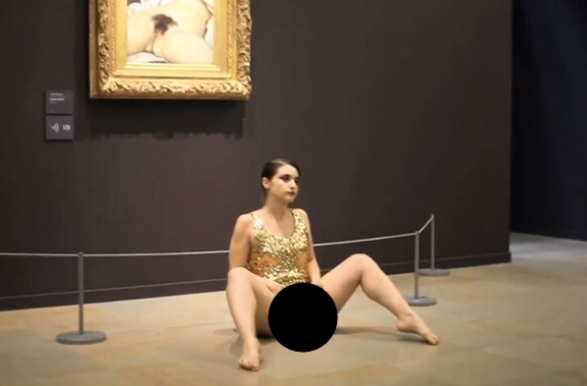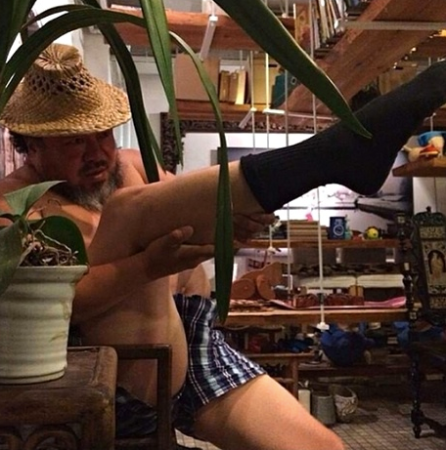
Just as I was beginning to despair with the recent ‘attention seeking’ acts of performance art, one young artist comes along and changes all that. YES, Deborah de Robertis constitutes a piece of performance art work that directly plays with and challenges Gustave Courbet’s ‘The Origins of the World’. Indeed if we are aware of the incredibly racy nature of Courbet’s 1866 painting we can only imagine the provocative nature of the act that this performance artist undergoes. If you weren’t aware, and as the title makes clear the painting references to the beginning of human life, the place where it all starts. It is a portrait of the female genitalia. Whilst the painting was seen as a great scandal at the time, today we recognise it an artistic treasure uniting themes such as realism, romance, eroticism and voyerism. It’s an incredibly powerful piece, it disturbs just as it incites.

Last week de Robertis, draped in a short gold sequin dress, entered ironically, rather inconspicuously into Room 20 of the Musée d’Orsay. She placed herself boldly and un-ashamedly directly in front of the Courbet masterpiece, but at the same time, she gave nothing away. A few seconds later she opens her legs revealing her womanhood. It is as raw as it is intense, and at the same time rather too easy to watch given the brashness of her display. But what is it about this piece of performance art that allows it to stand so far from other more recent contemporary pieces?
Before you go any further, check out the video of the performance here: *high sexual content ALERT* http://www.dailymotion.com/video/x1yaxll_une-artiste-expose-son-sexe-sous-l-origine-du-monde_news
There was something incredibly raw and emotional about her performance, surpassing the so called ‘aesthetics of beauty’ that the History of Art proclaims to, pushing her performance one step ahead. It is a declaration of a message about women by women to women, to men and to society. Did you know that in the 1990’s, less than 5% of the artists in the Modern Art section of New York’s Metropolitan Museum were women, but 85% of the nudes were female?
As always the most frustrating and often most entertaining part of reading articles like these is the sprawl of comments made by the great public. One ‘top commenter’ AKA a Carol Dixson naively says ‘I’m guessing about half the population in the world has one. Hers is special? This “artist” needs to get over herself.’ It is comments (attitudes) like this that seems to disregard the powerful message behind the act of performance art. If you don’t like it that is fine, but with conceptual art, with performance art, it’s more the message or concept behind it that becomes the most powerful. I don’t think those gallery-goers or indeed the security staff at the Orsay will forget about this incident for a long time. And why should they?
Who knew that a vagina that in art is so treasured, becomes so disturbing and hated in real life? Talk about hypocrisy!


Despite the much despised custom that the French adhere to move things at a very glacial pace, it still didn’t take long before De Robertis was removed by security staff. She has been handed over to the police who have the power to charge her with sexual exhibitionism.
But De Robertis justifies her performance. ‘If you ignore the context, you could construe this performance as an act of exhibitionism, but what I did was not an impulsive act,” she explained to Luxemburger Wort. “There is a gap in art history, the absent point of view of the object of the gaze. In his realist painting, the painter shows the open legs, but the vagina remains closed. He does not reveal the hole, that is to say, the eye. I am not showing my vagina, but I am revealing what we do not see in the painting, the eye of the vagina, the black hole, this concealed eye, this chasm, which, beyond the flesh, refers to infinity, to the origin of the origin.’
I couldn’t agree more with the brave young woman and neither it seems did the surprised gallery-goers who were quick to applaud her performance. Why call her brave? She believed in promoting her own message so much that she sacrificed her own position and persona to do so. Displays of sexual exhibitionism in such a public place like the Musée D’Orsay are going to get you arrested. Yes she broke the law, yes the performance was extremely sexually explicit and yes it came with absolutely NO warning, but this was the very beauty of it! And there is something incredibly powerful and beautiful about her performance. It’s funny how quickly the public go a-wall when a woman’s genitalia is involved.
Last time I checked almost 50% of the population have a vagina, and the other 50% are no stranger to them, so why the outcry? Does it take a nude performance artist disrupting a casual day of museum revelry to make the world notice? Apparently so…






























